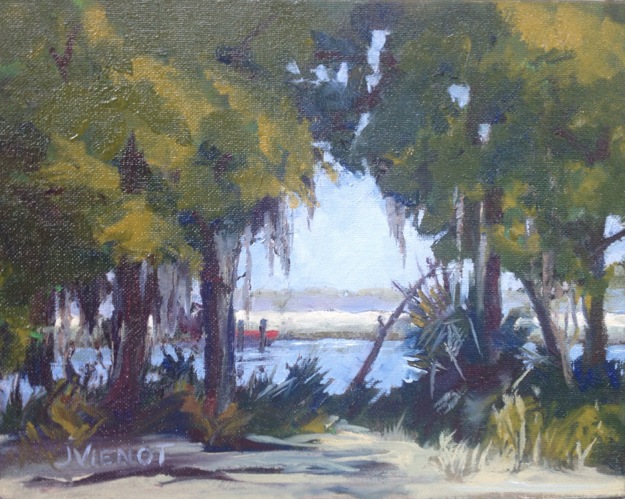Plein Air Painting on a Road Trip
Last Friday I drove a friend, Leslie, up to Birmingham for her doctor appointment, on the condition that I could paint before we left the next day. To my pleasant surprise, she wanted to try painting too!
I had brought my usual plein air backpack and paints, but in my vehicle I also keep a Guerrilla Painter kit, which is a small box containing oil paints, palette, brushes, and everything else needed for spur-of-the-moment painting, for times when something just has to be painted but catches me without my full backpack. So I set Leslie up with that kit. I toned our canvases a light orange, and while they dried, I laid out Leslie’s palette, with a good dollop of each of the primary colors, plus another hue of blue, and also white. A little linseed oil and some solvent completed the set-up. We were at Oak Mountain State Park, and we picked a view of the lake with a sweet cove in the foreground, lush greens everywhere. I stopped painting every 20 minutes or so to reassure Leslie who seemed ready to throw away her efforts every time I turned around. She stayed with it until to her surprise, she finished her first plein air oil painting! I always find myself a little surprised too, at the end of nearly every plein air session, to have a finished painting, or very nearly finished, after 60, 90, or 120 minutes of such struggle, such searching for the right colors and strokes to express the truth that I see.
And afterwards, as we were driving back home, we found ourselves in that frame of mind that comes only after that intense focus, that blissful sense of the present moment, when nothing exists except the immediate which becomes intensely magnified by its undistracted singularity. The scenery we were driving through was more beautiful. The rolling hills and green roadsides were in high definition and “Technicolor”. It was what I now recognize as that ecstatic state of awareness brought on by plein air painting, similar to meditation or any other pastime requiring sincere concentration.
Below is my finished painting from this adventure at Oak Mountain State Park, and another from Boggy Bayou State Park in Niceville, FL, where I met up with the Emerald Coast Plein Air Painters 2 weeks ago.
But sometimes a painting is not finished, usually due to the light changing, or bugs biting, or weather threatening. Below are 3 unfinished studies, one of the spring at Ponce de Leon State Park, FL, one of a cedar at Camp Helen State Park, and one of the multi-colored leaves of some potted plants in front of the gazebo at Grayt Grounds of Monet Monet.
 |
 |
 |
As always, most of my paintings and images are available for purchase. Contact me if you are interested. — Joan Vienot








